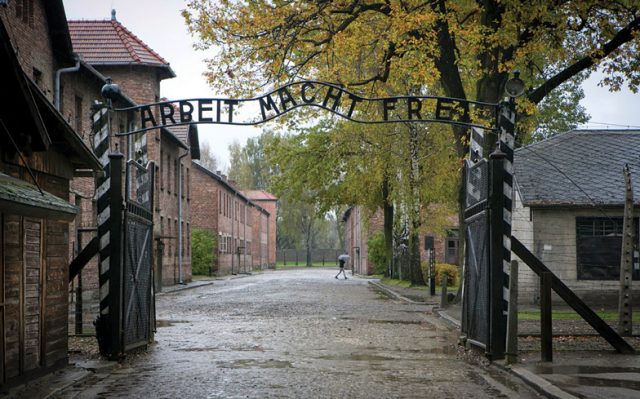
27 January marks the 72nd anniversary of the liberation of Auschwitz-Birkenau.
Its extent of torture is unparalleled in European history; unthinkable by any civilisation. What happened within the barbed gates of Auschwitz remains the deep shame of a now peaceful continent. The Nazi concentration camps were the abattoirs of humanity, making it their business to kill as quickly and mercilessly as possible.
Though it may be an impossible episode to comprehend, as the 72nd anniversary of Auschwitz’s liberation dawns on 27 January, comprehend it we must. It’s guys like us – if we’d been born in a different nation in a different time – who’d have seen first-hand the ugliest face of human oppression.

Exact estimates of deaths at Auschwitz are difficult to come by. The killings were so fast – the disabled, young and elderly were frequently killed immediately on arrival – that reliable registers don’t exist. It’s a figure upwards of one million.
The Jews, gypsies, Jehovah’s Witnesses, criminals and the politically outspoken were viewed by Nazis as incompatible with their Aryan race. So, too, were homosexuals. It was a declared aim of the Nazi regime to completely eradicate gay men.
More than 100,000 were arrested. Thousands upon thousands perished, either through gas chambers or by torture. By 2012, all known gay survivors had died. But other survivors of this human atrocity continue to walk among us. The horrors of Auschwitz are still alive.
Before Nazi rule, Berlin had been one of the most open cities in the world. Gay bars and dance halls had sprouted across metropolitan landscapes, and many gay men and women led open, contented lives.
“Today it’s hard to imagine what it was like in Berlin after the 1914-18 war,” recalled Heinz F, one gay survivor, then aged 94. “In Berlin those were the golden years.”
Paragraph 175 of the German Penal Code had prohibited homosexual acts since 1871, but the Weimar Republic had seen a change in public attitudes. Though it technically remained illegal, the law had become semi-redundant. “We were free in the whole of Berlin, we could do what we wanted,” he recalled.
Dr Magnus Hirschfeld was a prominent physician at the time. A gay man himself, he founded the Institute of Sexology, considered to be the first organisation of the modern era to promote gay and trans rights, and campaigned for the repeal of Paragraph 175. He built up a library of books and historical documents on sexuality and the human form that, even to this day, is hardly rivalled.
The campaign had real momentum, and was backed by some 5,000 influential signatures – including that of Albert Einstein. Though the reform initially struggled, Hirschfeld continued to argue ardently for the change, resorting to what we would now know as ‘outing’: naming gay members of the government in a bid to expose their opposition as hypocritical. This controversial method saw the tide change among those with power, with a realistic prospect of some legal equality emerging by the late 1920s.
On 30 January, 1933, it all changed. Adolf Hitler became Chancellor with the strong support of German people and, within a month, had ordered the closing of all gay venues. Four days later, the Reichstag was burned to the ground. Communist opposition leaders blamed the partner of Ernst Röhm: one of Hitler’s closest allies in the Nazi party, and gay.
On 6 May, Hirschfeld’s extensive library was destroyed in retaliation. As they did with the Jews, the Nazis sought to eradicate any whisper of an alternative to their tyranny.
“There was an incredible atmosphere of fear,” the last gay survivor, Gad Beck, who died in 2012, recalled of those early Nazi months. “Things used to be happy and care free, but now they were being persecuted. It didn’t seem like persecution to me, since the bar was still open. But they said this bar is only open to round us up. They did this again later with the Jews. They’d let them keep their meeting places so they could snatch them up.”

Heinrich Himmler became obsessed with the idea that homosexuality was an infectious disease, endangering Hitler’s programme to increase the master race.
As the Nazis rounded up all those who didn’t fit their master race, gay men too were ferried into the harbours of death – some 15,000 labelled with pink triangles and sent to their likely end. Though they were small in number compared to other persecuted groups, a special barbarity was reserved for the pink triangles. Beatings, “extermination through labour” in the work quarries and cases of forced castration. They also suffered the homophobia of fellow inmates.
Rudolf Brazda, who died in 2011, recalled the disdain of being seen to have the pink triangle: “The other prisoners would say, ‘Oh looks, this one’s a fag.’”
Brazda had kept his silence until 2008, when a memorial for the gay victims of the Holocaust was unveiled and Berlin’s gay mayor marked their passing. Finally ready, he contacted the mayor to tell his story.
As a young man, Brazda led a happy and open life in Leipzig, Germany. In 1937, Brazda was arrested for ‘unnatural lewdness,’ and sentenced to six months incarceration after officers found love letters he’d written to his boyfriend.
Soon after, a more systematic, brutal persecution began. “The Nazi stormtroopers dragged us out by our hair,” Brazda recalled. “We gays were like hunted animals. Wherever I went with my companion the Nazis were always already there.”
Arrested again in 1941, he was this time sent to a concentration camp, given the number 7952, and made to sew a pink triangle on to the left breast of his camp uniform. “I didn’t understand what was happening but what could I do? Under Hitler you were powerless,” he recalled.
“I arrived in a very big room. There was a pool there. In that pool we had to undress, and we had to bathe, naked. It was called ‘disinfection.’ In that moment, an SS officer pushed my head under the disinfectant liquid. I still had my gold chain, with a cross. It was a gift from my boyfriend. He ripped it and asked if I was a churchgoer. Of course I didn’t answer.”
He was subject to forced labour and remained there for 32 months.
To win their release from the camps, some gay men were forced to undergo mutilation – frequently tantamount to murder – in so-called medical experiments by Nazi doctors, who insisted that homosexuality was a disease that could be cured. Hitler also ordered the death penalty for any SS officers found to have engaged in homosexual relations.
On 3 August, 2011, Rudolf Brazda died at the age of 98, in Bantzenheim, France. In the final years of his life, he continued to tell his story as a warning to future generations of what happens when we don’t respect differences. During these last years, he said: “If I finally speak, it’s for people to know what we, homosexuals, had to endure in Hitler’s days. It shouldn’t happen again.”







